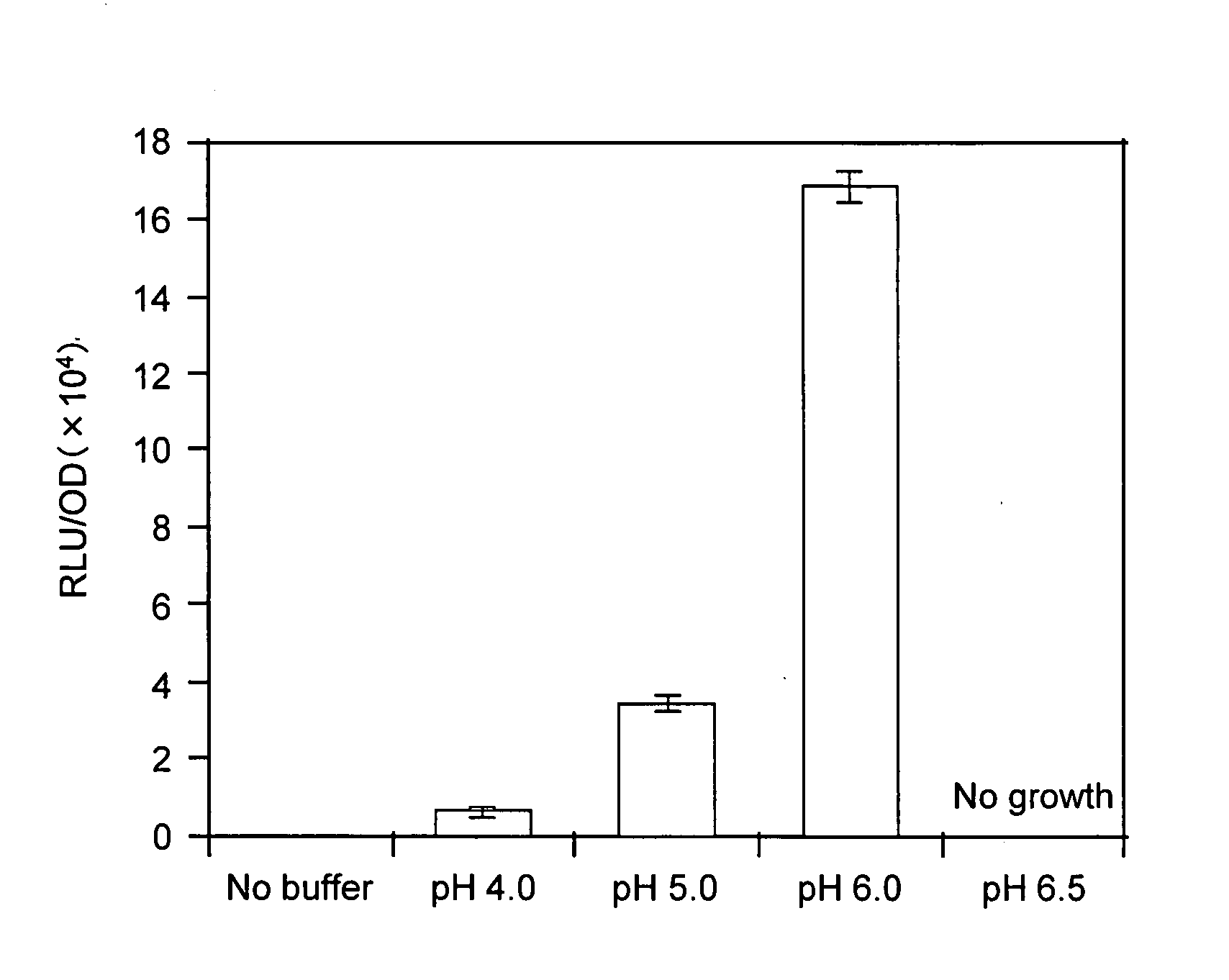Reporter Assay Using Secrectory Luminescent Enzymes
a luminescent enzyme and reporter assay technology, applied in the field of reporter assay methods, can solve the problems of difficult to quantify mrna, difficult to achieve the expression of a human protein, and inability to construct an appropriate transformant that can be used for reporter assay for i>e. coli, etc., to achieve convenient and highly sensitive reporter assay
- Summary
- Abstract
- Description
- Claims
- Application Information
AI Technical Summary
Benefits of technology
Problems solved by technology
Method used
Image
Examples
example 1
Examination of the Secretory Expression of Cypridina-noctiluca-secretory Luciferase in Yeasts and the Optimum pH of the Culture Solution Thereof
(1) Production of a Transformant (Transformed Yeast) Containing Cypridina noctiluca Secretory Luciferase
[0133] With the use of cDNA (SEQ ID NO: 1) encoding Cypridina noctiluca-secretory luciferase (the amino acid sequence set forth in SEQ ID NO: 2; hereafter to be referred to as “CLuc”), the secretory expression of the secretory luciferase was induced in budding yeasts (Saccharomyces cerevisiae). In addition, the pH condition of a medium used for the secretory expression of CLuc was examined.
[0134] First, a plasmid containing CLuc cDNA (hereafter to be referred to as “pcDNA-CL”) was used to amplify cDNA encoding a mature protein (hereafter to be referred to as “mature CLuc cDNA”) obtained by removing a CLuc secretory signal peptide (1st to 18th amino acids in the amino acid sequence of CLuc set forth in SEQ ID NO: 2) from pcDNA-CL by pol...
example 2
Examination of pH and Salt Concentration Upon CLuc Activity Measurement
[0174] The conditions of pH and salt concentration upon CLuc activity measurement following the secretory expression of CLuc in yeasts were examined.
[0175] A culture supernatant containing αCLuc secreted from the transformant comprising pCLuRA-TDH3 that had been prepared in Example 1 was prepared as with the case of Example 1. The pH of medium was determined to be 6.0.
[0176] In order to set the pH upon CLuc activity measurement, Cypridina luciferin was diluted with buffer solutions at different pH levels (potassium phosphate buffer solutions (KPi) at final concentrations of 100 mM or Tris-hydrochloric acid buffer solutions (Tris-HCl)) such that the obtained diluted solutions (2.5 μM) were used. In addition, each Cypridina luciferin diluted solution was added to the culture supernatant in a volume 4 times that of the culture supernatant. CLuc activity measurement was carried out as with the case of Example 1. F...
example 3
Examination of Luciferin Concentration Upon CLuc Activity Measurement
[0180] Luciferin concentration upon CLuc activity measurement following the secretory expression of CLuc in yeasts was examined.
[0181] A culture supernatant comprising aCLuc secreted from the transformant comprising pCLuRA-TDH3 that had been prepared in Example 1 was prepared as with the case of Example 1. The pH of the medium was determined to be 6.0. Cypridina luciferin used was diluted with 100 mM Tris-HCl solutions (pH 7.4) at different concentrations. That is, Cypridina luciferin was diluted so as to have final concentrations of 0.25, 0.5, 1.0, 2.0, and 4.0 μM in reaction solutions. Also, the Cypridina luciferin diluted solutions with different concentrations were adjusted to have the same concentration of ethanol used for dissolution upon the obtaining of preservative solutions.
[0182] In addition, a stock solution of the culture supernatant of the transformant comprising pCLuRA-TDH3 was separately serial-d...
PUM
| Property | Measurement | Unit |
|---|---|---|
| pH | aaaaa | aaaaa |
| pH | aaaaa | aaaaa |
| temperature | aaaaa | aaaaa |
Abstract
Description
Claims
Application Information
 Login to View More
Login to View More - R&D
- Intellectual Property
- Life Sciences
- Materials
- Tech Scout
- Unparalleled Data Quality
- Higher Quality Content
- 60% Fewer Hallucinations
Browse by: Latest US Patents, China's latest patents, Technical Efficacy Thesaurus, Application Domain, Technology Topic, Popular Technical Reports.
© 2025 PatSnap. All rights reserved.Legal|Privacy policy|Modern Slavery Act Transparency Statement|Sitemap|About US| Contact US: help@patsnap.com



